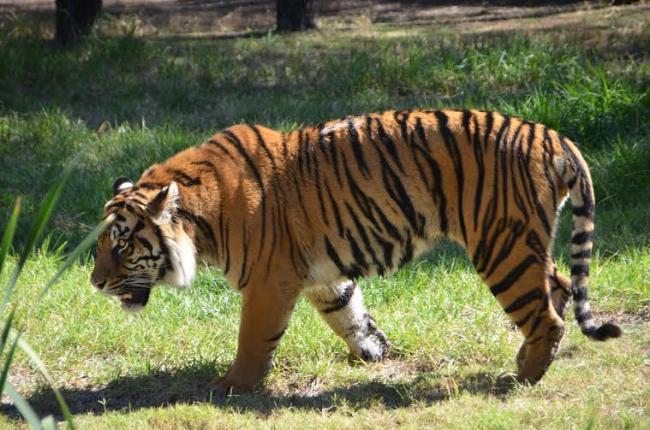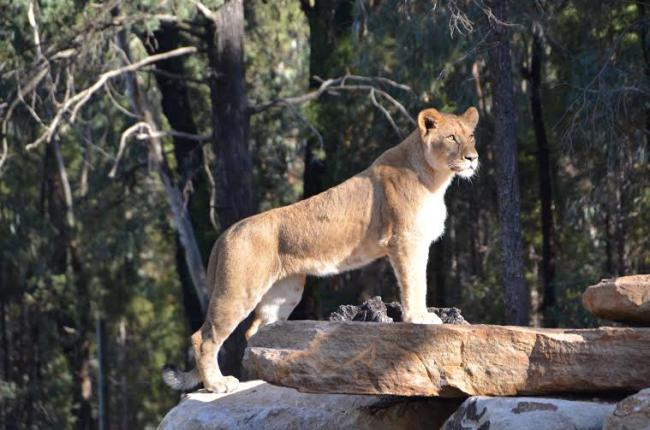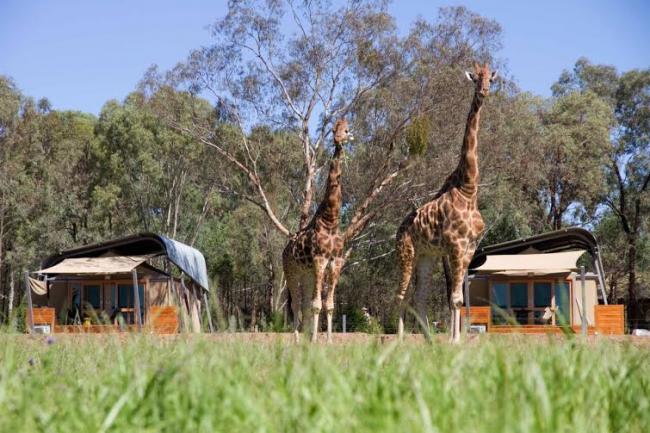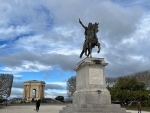April 18, 2024 22:59 (IST)

Bit of Africa in Australia
I have been to a few wildlife sanctuaries in Africa and India and savoured the beauty of the beasts in their own natural domain. The thrills and excitement of wildlife sightings came back to me when I recently visited the Taronga Western Plain Zoo in Dubbo, located in the central region of NSW, about 6 hours north-west of Sydney .This 300 hectare oasis of woodland and irrigated grassland is home to hundreds of animals of different species, some of which are endangered. Theyfreely wander in their self-contained hideouts without metal bars, cages and concrete slabs; clever use of lakes, moats and unobtrusive fencing separating them from visitors. This invariably creates a pseudo jungle scenario and an impression of being almost face to face with the animal world as in any wildlife reserve.
A 6km circuit meanders through the natural bushland powdered with various types of trees from eucalyptus and gum to African acacia. There are multiple ways of rambling inside the expansive arena. The energetic prefer to walk or ride bikes, while some drive their own car or move on an electric driven cart.
While there over a two-day period, I came across almost every specie that I had earlier glimpsed in Africa. I spotted tall giraffes stretching out to eat their meals high in the trees, zebras nuzzling each other at a waterhole, mother and cub rhino playing hide and seek,buffaloes, elands and deer grazing in sprawling savannah, hippos slumping in the muddy pools, elephants playfully shrugging off dust from their bodies and a lion clan - male, female and their three cubs having quality family time.
The adrenaline pumping thrills came from the big cats – cheetahs and tigers.

When went past the cheetah home, I didn’t see any of them, so decided to move on.But the zoo keeper told me to wait as two of them, hiding in the grassland,could come out any moment. Now that anxious waiting experience was no different to holding breadth to trace a predator at a wildlife reserve in Africa. And when the two cheetahs actually appeared on the scene, my joy knew no bounds.
I imagined once again being at the Serengeti in Tanzania, lucky enough to spot a cheetah. The animal viewing was much closer here andbetter. With their spotted pelage blending easily into the high, dry grasses, the two cheetahs after emerging from their den ran around a little to reveal they are the world’s fastest land mammal. When spotted us, the onlookers, they slowed down and came near. Their slender body, deep chest, small rounded head with black tear-like streaks on the face were only meters away.They hiked up to a set of rocks to see us better. Beauty of the beasts switched usinto silent mode. Nothing can be heard other than clicking of camera shutters and occasional verbal expressions like wow, awesome and splendid. Experience was similar with the Sumatran tigers.I couldn’t locate any of them when at their quarter until another visitor spots one in the waterway.

Our long wait for the beast to come out of the water was highly rewarding. It was a full grown male tiger. He majestically posed in front of us for photographs before vanishing into the bush. Seeing the images later, my friends thought them to be captured at the Ranthambore National Park in India where I went recently to chase tigers.
This zoo provides much more than animal displays. It is also an education base, a research hub and a world- renowned wildlife conservation and preservation centre for species from throughout the world. Since opening in 1977, the zoo has successfully bred a number of animals, including black rhinos, Asian elephants, lions, hippos and more.
A motivating part of the journey here is the learning experience. The omniscient zoo keepers during pre-set feeding times provide interesting information about the animals – their habits, behaviours, diet, mating, gestation periods and many more facts and figures , like the difference between various variety of rhinos and why African elephants have much bigger ears compared to their Asian counterparts. We learn sadly how rhinos are getting on verge of extinction. Driven by a growing market for rhinohorn in China and other parts of Asia, 1,338 rhinos were killed by poachers across Africa in 2015. Back in 1994, the zoo brought in six black rhinos from Zimbabwe as a part of their breeding program.
Since that time the zoo has bred 11 Black Rhinos. In 2010 the first second-generation calf, descended from the zoo-bred rhinos, was born.The killing figures of elephants, because of ivory,are also alarming. More than 24,000 elephants died from poaching in 2015. The zoo has special programs to conserve both African and Asian elephants.All the information is delivered in a child-friendly way so that even the youngest visitor returns home withsome knowledge about animals.

First of its kind in Australia, this zoo is also a venue to relax and enjoy. Inside the sprawling complex there are plenty of places to stop and rest in the sun or under shady trees and tocollapse on the grass or have a picnic lunch with friends and family. In the main plazathere's a cafe for takeaway or a sit down meal, and a popular kiosk at the halfway mark of the main circuit. There are options of staying inside the complex as well, so as to wake up by the roar of a lion and to be greeted by a giraffe as the first ray of the sun colour up the yellow grassland.
For anyone who hasn’t been to Africa, this zoo offers somethinned sights , sounds and smells of the wildlife setting from there, adequate for some to ignite their inner Meryl Streep and Robert Redford as seen in the Hollywood blockbuster “Out of Africa”.

Fact Box
Getting there: Fly Air India (www.airindia.com) direct from Delhi to Sydney from where Dubbo is well connected by rail, road and air. While Rex Airline (www.rex.com.au) has daily 1 hour 10m flights, a relaxing way to reach Dubbo is by jumping aboard the XPT train service (www.nswtrainlink.info) from Sydney Central station. Popular with outsiders, this 6.5 hour rail journey offers passengers a great vista of rural Australia.
Accommodation: There are plenty of motels in the Dubbo city from where the zoo is only a short drive away. Cattleman’s Country Motor Inn (www.cattlemans.com.au) is a good choice. Inside the zoo, Zoofari Lodge is an intimate retreat offerings a private and luxurious African safari style experience (www.taronga.org.au/accommodation).
Support Our Journalism
We cannot do without you.. your contribution supports unbiased journalism
IBNS is not driven by any ism- not wokeism, not racism, not skewed secularism, not hyper right-wing or left liberal ideals, nor by any hardline religious beliefs or hyper nationalism. We want to serve you good old objective news, as they are. We do not judge or preach. We let people decide for themselves. We only try to present factual and well-sourced news.
Support objective journalism for a small contribution.
Latest Headlines
UNGA president says tourism ‘intrinsically susceptible’ to climate shocks, political unrest, pandemic threat Wed, Apr 17 2024
Ford's Theatre: Of President Lincoln and the Man Who Killed Him Fri, Apr 12 2024
Resort Island – Mauritius Mon, Apr 08 2024
Lahaul Spiti district administration directs tourists, locals to avoid unnecessary travel Mon, Apr 01 2024
Hotel Richer de Belleval: Where luxury meets bistronomy in southern France city Montpellier Sat, Mar 30 2024
The Frankfurt Marriott: Germany's tallest hotel is a smart pick for leisure and work visits Thu, Mar 21 2024
Chicago paints the city green to celebrate St. Patrick’s Day Sun, Mar 17 2024
British Deputy High Commissioner Andrew Fleming says India forecast to be a billion-dollar visitor market for UK from 2025 Fri, Mar 15 2024
Madhya Pradesh Tourism board signs agreement with MakeMyTrip, redBus Thu, Mar 14 2024






